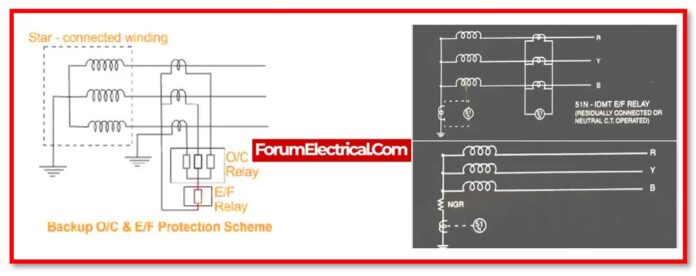One of the most important components of power system safety is the transformer IDMT (Inverse Definite Minimum Time) Overcurrent & Earth Fault Relay Settings. By identifying and reacting to abnormal current conditions, these relays serve an important function in protecting transformers and the whole electrical network.
Function of IDMT Relays
1). Overcurrent Protection
When the current in the circuit exceeds a certain threshold, IDMT overcurrent relays are intended to trip. Damage carried on by overloads & short circuits must be avoided at all expenses due to this protection.
2). Earth Fault Protection
Specific devices called earth fault relays are used to detect electrical system ground problems. Safety issues may result from these faults which can happen as a result of damaged insulation or unintentional contact with grounded objects.
Important Factors
1). CT Ratio
The relay’s ability to distinguish between the main current and the secondary current depends on the current transformer (CT) ratio. For relay accuracy, choosing a CT ratio correctly is essential.
2). Plug Setting
The current level below which the relay initiates its protective action is specified by this parameter. It is often stated as a proportion of the CT secondary current.
3). Time Dial Setting
The relay’s reaction time may be modified using the time dial setting. It is configured as a time multiplier & affects how soon a defect causes the relay to trip.
IDMT Characteristics
The tripping time for IDMT relays lowers as the size of the fault current grows due to their inverse time characteristic of operation. This curve implies that the relay runs more quickly for greater fault currents, improving system protection.
Settings for Earth Faults
Overcurrent relays and earth fault relays may have separate settings. To quickly find ground defects, they utilize lower pickup current levels & quicker time dial settings.
Coordination
For the right relay to react to a failure in a power system, there must be coordination between them. By enabling downstream relays to function first and allowing upstream relays to coordinate as required, it avoids unneeded system disturbances.
Testing and Commissioning
To ensure optimal functioning, relay settings should be properly examined and validated. To test the relay’s reaction time and communication with other protective devices, fault conditions are simulated.
Significance of Documentation
Relay settings must be thoroughly documented for maintenance and future use, including CT ratios, plug settings, clock dial settings, & coordination studies.
Conclusion
In conclusion, the safety and dependability of power systems depend on the settings for the transformer IDMT overcurrent & earth fault relays. Relays that are set up correctly protect equipment and people from catastrophic failures. In order to maintain the reliability of the electrical network, these parameters should be carefully chosen, tested, and recorded. In order to provide efficient protection and problem response, engineers and technicians are vital to the operation.









